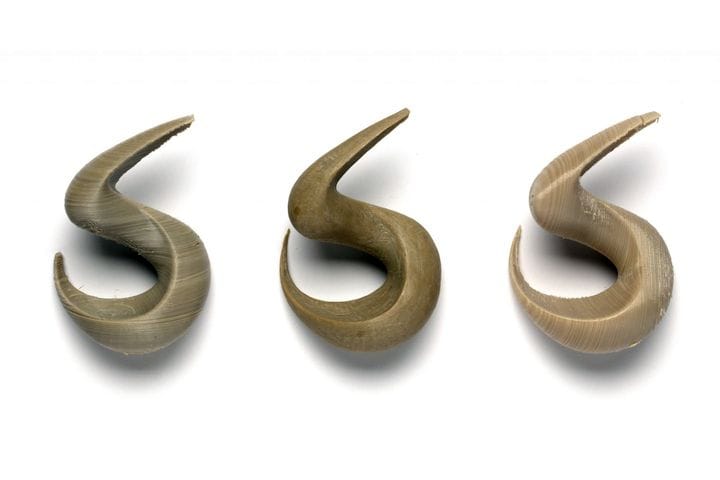![High-temperature 3D prints made with Solvay materials [Source: Aerosint]](https://fabbaloo.com/wp-content/uploads/2020/05/image-asset_img_5eb09a3dba602.jpg)
A partnership between Solvay and Aerosint could lead to high-temperature SLS 3D printing.
You might not be familiar with Aerosint, but they are a 3D printing start up company that has developed a very unusual powder-based system. It’s similar to the familiar SLS powder bed/laser process but with a twist: more than one powder can be used in a single job run.
We explored this unusual system in a post about a year ago, where we explained their unique process. Basically it is an SLS system, except that the recoater is more sophisticated. Most recoaters simply deposit a precise and thin layer of the powder material loaded in the printer at that moment. The material is always a single material powder, typically nylons.
The Aerosint System differs in that the recoater contains two hoppers, each filled with a different type of powder. The recoater is able to selectively deposit one or the other powders in each specific location on the print bed. Thus, a new layer Will have a mix of two different materials in powder form.
![The dual-powder recoating system for SLS 3D printing [Source: Aerosint]](https://fabbaloo.com/wp-content/uploads/2020/05/image-asset_img_5eb09a3e2617c.jpg)
This allows the possibility of multi-material 3D prints, something quite impossible on every other SLS machine. They are even working on the process for multi-metal 3D printing.
However, even though multi-material 3D prints would be theoretically possible, it’s unlikely that would be the typical use of these machines. Instead it’s expected that the secondary powder would be an inexpensive, non-fusible support material. When the laser sweeps across the layer, there would be no fusing of this support powder, meaning it should be easily recoverable for reuse.
This approach could save a significant amount of money for those using SLS processes. Normally the unfused support powder in an SLS machine is in fact the model material, which tends to be expensive. Even worse, this expensive support material can be easily corrupted by splashes of hot model material or stray laser pulses. To reuse that powder one must sieve out any agglomerations before reloading into the printer.
Such problems should not occur with Aerosint’s system.
It seems that the company has realized there’s another very powerful use case that can be obtained with this configuration: high-temperature SLS 3D printing.
In normal SLS systems the possibility for high-temperature 3D printing is challenging because the extremely high temperatures required to melt materials can leak past the model boundary and corrupt other powder in the build chamber. And of course, high temperature materials are among the most expensive in 3D printing. This is why you don’t see SLS printers using PEEK, for example.
But what if the Aerosint system was used for high-temperature 3D printing? The non-fusible support material could be immune to stray high temperatures. It maybe possible to SLS 3D print PEEK.
That seems to be the plan as Aerosint has struck a deal with Solvay to develop suitable high-temperature 3D print materials for this system. Solvay is a large chemical company, specializing in high-temperature materials, so they are an ideal partner for Aerosint. They explain:
“High-performance polymers such as KetaSpire polyetheretherketone (PEEK) and Ryton polyphenylene sulphide (PPS) have the potential to open new avenues for Additive Manufacturing (AM) in demanding applications, but their adoption with key powder fusion technologies such as selective laser sintering (SLS) remains limited today.”
Up to now most high-temperature 3D printing has been done with extrusion-based machines, but these have some limitations in resolution and geometry. If Aerosint is able to produce this system, we could then see many parties making use of their system to produce complex high-temperature prints.
Via Aerosint











An inventive designer has developed a method for producing 3D paper objects using recycled paper and 3D printed molds.